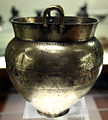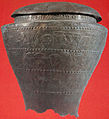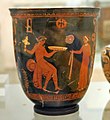Situla

Situla (plural situlae), from the
Decorated Iron Age situlae in bronze are a distinctive feature of Etruscan art in burials from the northern part of the Etruscan regions, from which the style spread north to some cultures in Northern Italy, Slovenia, and adjacent areas, where terms such as situla culture and situla art may be used.
Situla is also the term for types of bucket-shaped Ancient Greek vases, some very finely painted.
Bronze Age Europe
Bronze situlae were a feature of the
Iron Age Europe
Typical
The Etruscan examples are most characteristic in the 7th century BC, though continuing well afterwards. They are in various materials, from pottery to bronze, and sometimes silver. The Situla of the Pania is an unusual luxury Etruscan example in ivory, and the Bocchoris vase a ceramic import from Egypt from an Etruscan burial. The Este and Hallstatt examples are later, with the Slovenian production reaching a peak in quality in the 5th century, up to about 400 BC, well after the Hallstatt period had ended over much of its area.[7] Some were found containing cremated ashes, but they were essentially luxury vessels used at feasts.[8]
Numerous Hallstatt situlae were found in Slovenia, mainly (19 of them) in the area of
Later Etruscan and then Roman styles favoured a simple shape curving from the base, becoming vertical at the top, with a wide mouth and no shoulder, but sometimes a projecting rim. These had a variety of uses, including for washing and bathing. Any decoration was often concentrated on the upper part of the sides.
Situla art
Situla art was an important means of transition of Greek-derived motifs from the Etruscans through the regions to the north to the emerging La Tène culture further west.[11] According to Ruth and Vincent Megaw, "Situla art depicts life as seen from a masculine viewpoint, in which women are servants or sex objects; most of the scenes which include humans are of the feasts in which the situlae themselves figure, of the hunt or of war".[12] Similar scenes are found on other vessel shapes, as well as bronze belt-plaques.[13] The processions of animals, typical of earlier examples, or humans derive from the Near East and Mediterranean, and Nancy Sandars finds the style shows "a gaucherie that betrays the artist working in a way that is uncongenial, too much at variance with the temper of the craftsmen and the craft". Compared to earlier styles that arose organically in Europe "situla art is weak and sometimes quaint", and "in essence not of Europe".[14]
Except for the Benvenuti Situla, men are hairless, with "funny hats, dumpy bodies and big heads", though often shown looking cheerful in an engaging way. The Benevenuti Situla is also unusual in that it seems to show a specific story.[15]
-
Bronze situla from Hallstatt, 800-750 BC
-
Etruscan with geometric ornament, 700-550 BC
-
Etruscan "Situla della Pania", 7th century BC
-
Etruscan, silver, Chiusi, c. 650 BC
-
Etruscan, with silver mounts, Cerveteri c. 650 BC
-
Clearer reproduction of the Etruscan bronze situla at the top of the page.
-
Situla Benvenuti, Este culture, c. 600 BC
-
Bronze vases & situlae, Eastern zone ofKleinklein
-
Golasecca culture II A, turn of the 7/6th century BC
-
TheVače situla, Slovenia, 5th century BC
-
Late Etruscan, 3rd century BC, bronze
-
Late Etruscan, c. 300 BC, pottery
-
Roman bronze situla from Germany, 2nd-3rd century
-
Ancient Greek (Apulian) pottery situla vase, 340-320 BC
-
Roman silver situla with lady (or Venus) bathing, 190-210 AD
Attribute of Isis

The term is also used for pails carried by figures in other art forms; according to
Christian situlae
Elaborate
Four richly carved
-
The Basilewsky Situla, 920, Ottonian, in ivory
-
Ottonian ivory situla with scenes from the Life of Christ c. 860-880 AD
Outside Europe
The term may also be used for similar vessels from other cultures, especially the ancient Middle East and China and Vietnam.[24]
Bronze bath buckets are also found in
-
Situla fromLuristan, 9th century BC; note the "nipple" at the bottom
-
Egyptian, 305-30 BC, Ptolemaic Dynasty, bronze
References
Citations
- ^ MFA Boston, Attic vase situla Archived 2007-02-24 at the Wayback Machine
- ^ Kipfer, 518
- ^ "Situla". Institute for the Study of the Ancient World. 2022.
- ^ "History of Europe: The People of the Metal Ages – Rituals, religion and art". Britannica.com. Retrieved 8 November 2022.
In the stylistic development during the Metal Ages, two phenomena are of particular interest. The first is the development of the sun-bird-ship motif of the Urnfield Culture. The origin of this motif, which featured bird-headed ships embellished with solar disks, is not known, but over a short period about 1400 BCE it became common both as incised decoration and as plastic art throughout a vast area of eastern and central Europe. The similarity in execution and composition is remarkable and suggests a shared understanding of its meaning and the intensity of contact between distant areas.
- ^ Megaw, 34-39
- ^ Sandars, 223
- ^ Megaw, 34-39
- ^ Sandars, 224
- ^ "Novo mesto bogatejše še za eno poslikano situlo" [Novo mesto Richer for Another Painted Situla] (in Slovenian). Lokalno.si. 6 February 2006. Retrieved 15 December 2010.
- ^ "Application for the Title of the European Capital of Culture 2012" (PDF). City Municipality of Maribor. 2008.
{{cite journal}}: Cite journal requires|journal=(help)[permanent dead link] - ^ Sandars, 223-225; Megaw, 34-39
- ^ Megaw, 37
- ^ Sandars, 223-224
- ^ Sandars, 225, quoted
- ^ Sandars, 224
- ^ Witt, 55.Isis situla Archived 2012-02-26 at the Wayback Machine
- ^ Basilewsky Situla V&A Museum
- ^ image of Milan situla
- ^ Image of Aachen situla Archived 2011-07-22 at the Wayback Machine
- ^ Metropolitan Museum example
- ^ Lasko, 92-3
- ^ Though Lasko, 92 disagrees with this.
- ^ All except the New York situla are illustrated and discussed in Beckwith, pp.129-130, 135-136
- ^ Metropolitan, Vietnamese bronze situla
Sources
- Beckwith, John. Early Medieval Art: Carolingian, Ottonian, Romanesque, Thames & Hudson, 1964 (rev. 1969), ISBN 0-500-20019-X
- Kipfer, Barbara Ann. Encyclopedic dictionary of archaeology, Springer, 2000,
- ISBN 978-0300060485
- Megaw, Ruth and Vincent, Celtic Art: From Its Beginnings to the Book of Kells, 1989 (2001 2nd edn), Thames & Hudson
- Sandars, Nancy K., Prehistoric Art in Europe, Penguin (Pelican, now Yale, History of Art), 1968 (nb 1st edn.)
- Witt, Reginald Eldred. Isis in the ancient world, JHU Press, 1997 (2nd ed),
Further reading
- Beckwith, John. The Basilewsky Situla, 1963, HMSO
- Frey, Otto-Herman. Die Entstehung der Situlenkunst: Studien zur figürlich verzierten Toreutik von Este, 1969.
- Kastelic, Joze, and Karl Kromer, Guido Mansuelli. Situla Art: Ceremonial Bronzes of Ancient Europe, NY McGraw-Hill 1965






















